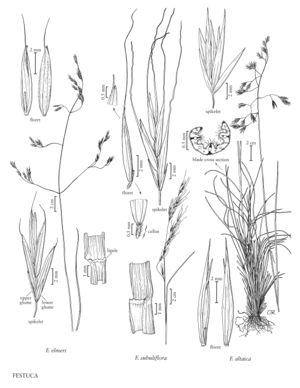Festuca subuliflora
Plants loosely cespitose, without rhizomes. Culms 40-125 cm, glabrous. Sheaths closed for less than 1/3 their length, glabrous or pubescent, shredding into fibers; collars glabrous or pubescent; ligules 0.1-0.5 mm; blades 2-6 (8) mm wide, flat or loosely convolute, abaxial surfaces glabrous or sparsely pubescent, adaxial surfaces pubescent, veins 13-29, ribs obscure to prominent; abaxial sclerenchyma in strands; adaxial sclerenchyma developed; pillars or girders present at the major veins. Inflorescences 7-20 cm, open, with 1 (2) branches per node; branches lax, spreading. Spikelets 8-12.5 mm, with (2) 3-5 florets. Glumes glabrous, lanceolate to subulate; lower glumes (2) 2.5-4 mm; upper glumes 3.5-5.5 (6) mm; calluses much longer than wide, pubescent at least basally; lemmas 6-9 mm, lanceolate, puberulent, particularly towards the bases, sometimes slightly scabrous, particularly towards the apices, apices minutely bidentate, awned, awns 10-15 mm, slightly subterminal, flexuous, or kinked; paleas about as long as the lemmas, intercostal region puberulent distally; anthers (2) 2.5-4 mm; ovary apices pubescent. 2n = 28.
Distribution
Calif., Oreg., Wash., B.C.
Discussion
Festuca subuliflora grows in shady sites in dry to moist forests, usually below 700 m. Its range extends from southwestern British Columbia to central California. Superficially, it resembles F. subulata (p. 402); it differs in having more elongated and distinctly hairy calluses, and often in having softly pubescent foliage and more strongly ribbed blades.
Selected References
None.
Lower Taxa
"narrower" is not a number. "sometimes wider than long" is not a number."decumbent" is not a number."longest" is not a number.
